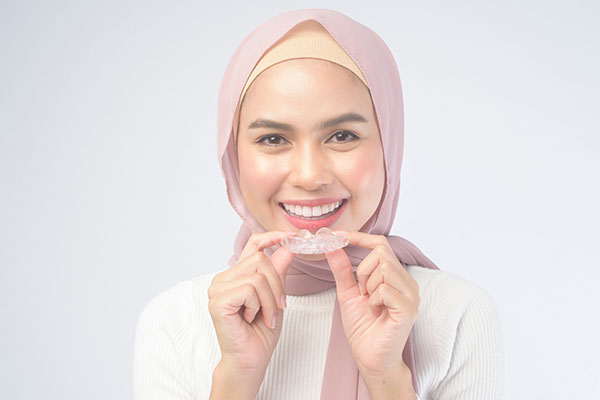 For many patients, Invisalign® treatment is a good alternative to traditional braces. Treatment time is often shorter, and patients can maintain better oral hygiene during the process. This type of orthodontic treatment uses a series of clear aligners to straighten teeth. The patient wears the trays for 20-22 hours a day, only removing them for eating and oral hygiene routines. The aligners put pressure on the teeth to move them into the correct position, and the patient changes aligner trays periodically so that movement keeps occurring.
For many patients, Invisalign® treatment is a good alternative to traditional braces. Treatment time is often shorter, and patients can maintain better oral hygiene during the process. This type of orthodontic treatment uses a series of clear aligners to straighten teeth. The patient wears the trays for 20-22 hours a day, only removing them for eating and oral hygiene routines. The aligners put pressure on the teeth to move them into the correct position, and the patient changes aligner trays periodically so that movement keeps occurring.
Guidelines for changing Invisalign® aligners
The patient changes Invisalign® trays based on the dentist's recommendation. This varies based on the patient's length of treatment and amount of orthodontic movement necessary.
Standard timeline for aligner wear
Typically, patients start by wearing aligners for two weeks at a time. After getting accustomed to wearing the trays, the patient may be able to change aligners sooner than two weeks. This depends on how quickly the teeth are moving into the right position. The patient may initially switch to 10-day changes, and if that goes well, the dentist may recommend weekly changes.
One of the main benefits of Invisalign® over regular braces is treatment time can be halved if the patient is compliant. Instead of visiting the dental professional only once a month to tighten braces, the patient can have new orthodontic movement happening every week.
When to change aligners more frequently
Many patients wonder when it is time to switch to weekly aligner changes instead of biweekly ones. While this varies in each case, there are a few signs to watch for. The aligners may start feeling loose after a few days, and the patient may not feel pressure on the teeth anymore. These are signs the patient's teeth are moving according to the treatment plan, so aligners can be changed more frequently.
Patients may also want to speed up treatment if there is a special event coming up, such as a wedding. With regular braces, altering treatment time is usually not possible. However, with Invisalign®, this is an option the patient and dentist can discuss.
What to do if trays do not fit
Sometimes, teeth do not move into the expected position on the expected timeline. When this happens, the patient may have to wear each set of aligners for a longer period of time. The dentist can check to see that the teeth are moving into position with each new Invisalign® tray, a process called tracking. If the teeth are not tracking, the tray may not fit well on the teeth. If the correct movements do not start occurring, the dentist simply requests a revision of the patient's case. In this scenario, the patient gets all-new aligners so that the process can continue to go smoothly.
Conclusion
Invisalign® is an attractive tooth-straightening treatment option for those who want to avoid traditional braces. When patients is compliant with all aspects of treatment, including aligner wear time, they can look forward to a beautiful smile.
Request an appointment or call Diamond Head Dental Care at 808-450-2101 for an appointment in our Honolulu office.
Recent Posts
There are many benefits to choosing Invisalign® clear aligners over metal braces for teeth straightening, including the ease of cleaning and routine maintenance. While clear aligners are considered more aesthetically pleasing than traditional braces, failing to take proper care of the trays can lead to discoloration or a buildup of bacteria in the mouth. Fortunately,…
Invisalign® and braces are very different tools that can give patients an even smile with straightened teeth. Because patients must wear teeth alignment devices for a while, you might wonder if you will need repairs to your device. Patients often wonder if one type of device needs more repairing than another. For most patients, one…
There are so many differences between traditional braces and Invisalign® aligners. You may be wondering which option is right for your alignment needs and if you will have to change your lifestyle. Many people choose to go through the Invisalign process because the trays are less conspicuous than traditional braces. Traditional braces can be very…


